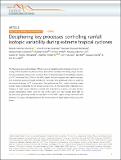| dc.creator | Sánchez Murillo, Ricardo | |
| dc.creator | Durán Quesada, Ana María | |
| dc.creator | Esquivel Hernández, Germain | |
| dc.creator | Rojas Cantillano, Daniela | |
| dc.creator | Birkel Dostal, Christian | |
| dc.creator | Welsh, Kristen | |
| dc.creator | Sánchez Llull, Minerva | |
| dc.creator | Alonso Hernández, Carlos M. | |
| dc.creator | Tetzlaff, Doerthe | |
| dc.creator | Soulsby, Chris | |
| dc.creator | Boll, Jan | |
| dc.creator | Kurita, Naoyuki | |
| dc.creator | Cobb, Kim M. | |
| dc.date.accessioned | 2019-11-29T21:06:44Z | |
| dc.date.available | 2019-11-29T21:06:44Z | |
| dc.date.issued | 2019 | |
| dc.identifier.citation | https://www.nature.com/articles/s41467-019-12062-3#citeas | |
| dc.identifier.issn | 2041-1723 | |
| dc.identifier.uri | https://hdl.handle.net/10669/79956 | |
| dc.description.abstract | The Mesoamerican and Caribbean (MAC) region is characterized by tropical cyclones (TCs), strong El Niño-Southern Oscillation events, and climate variability that bring unique hazards to socio-ecological systems. Here we report the first characterization of the isotopic evolution of a TC (Hurricane Otto, 2016) in the MAC region. We use long-term daily rainfall isotopes from Costa Rica and event-based sampling of Hurricanes Irma and Maria (2017), to underpin the dynamical drivers of TC isotope ratios. During Hurricane Otto, rainfall exhibited a large isotopic range, comparable to the annual isotopic cycle. As Hurricane Otto organized into a Category 3, rapid isotopic depletion coupled with a decrease in d-excess indicates efficient isotopic fractionation within ~200 km SW of the warm core. Our results shed light on key processes governing rainfall isotope ratios in the MAC region during continental and maritime TC tracks, with applications to the interpretation of paleo-hydroclimate across the tropics. | es_ES |
| dc.description.sponsorship | Universidad Nacional de Costa Rica/[SIA-0482–13]/UNA/Costa Rica | es_ES |
| dc.description.sponsorship | Universidad Nacional de Costa Rica/[SIA-0378–14]/UNA/Costa Rica | es_ES |
| dc.description.sponsorship | Universidad Nacional de Costa Rica/[SIA-0101–14]/UNA/Costa Rica | es_ES |
| dc.description.sponsorship | International Atomic Energy Agency/[CRP-19747]/IAEA/Austria | es_ES |
| dc.description.sponsorship | International Atomic Energy Agency/[COS7005]/IAEA/Austria | es_ES |
| dc.language.iso | en_US | es_ES |
| dc.source | Nature communications, vol.10, pp.1-10 | es_ES |
| dc.subject | Ciclón | es_ES |
| dc.subject | Mesoamerica | es_ES |
| dc.subject | Caribe | es_ES |
| dc.subject | 551.6 Climatología y estado atmosférico | es_ES |
| dc.title | Deciphering key processes controlling rainfall isotopic variability during extreme tropical cyclones | es_ES |
| dc.type | artículo original | |
| dc.date.updated | 2019-11-20T20:16:50Z | |
| dc.identifier.doi | 10.1038/s41467-019-12062-3 | |
| dc.description.procedence | UCR::Vicerrectoría de Investigación::Unidades de Investigación::Ciencias Básicas::Centro de Investigaciones Geofísicas (CIGEFI) | es_ES |


